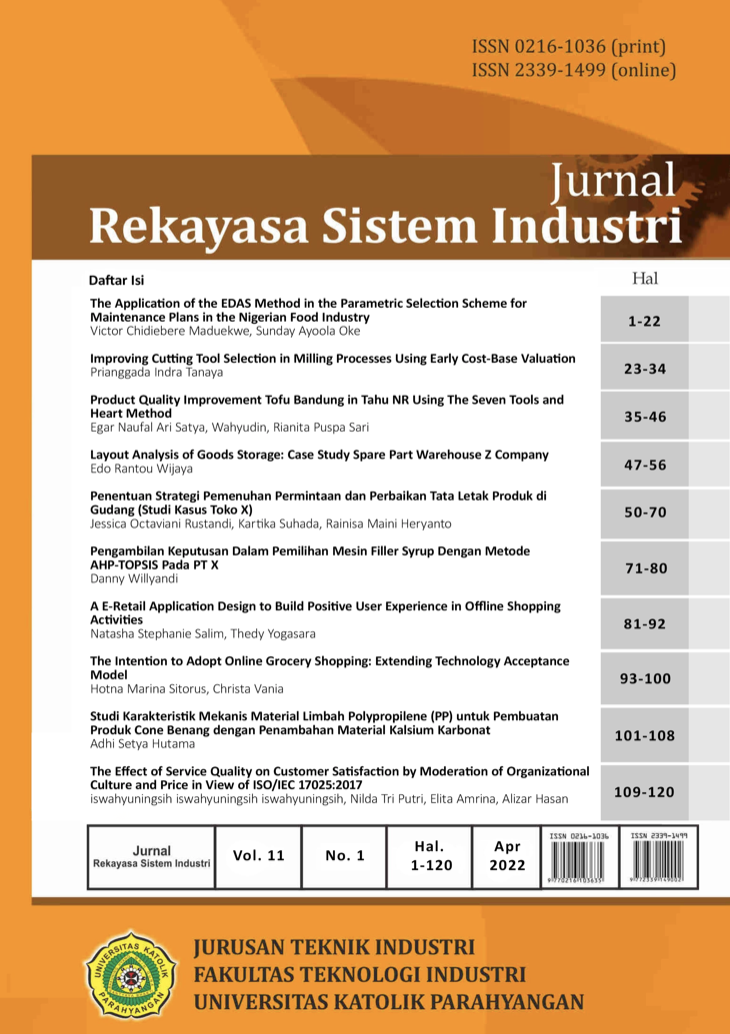Penentuan Strategi Pemenuhan Permintaan dan Perbaikan Tata Letak Produk di Gudang (Studi Kasus Toko X)
DOI:
https://doi.org/10.26593/jrsi.v11i1.5026.57-70Keywords:
class-based dedicated storage policy, inventory cost, optional, P, QAbstract
Fulfillment customer demand is main factor that have to be considered by company to win competitive competition. Right strategy is needed to meet this objective and create minimum total inventory costs. During COVID-19 pandemic, hygiene products become products that have skyrocketing demand, thus encouraging emergence of new stores selling it. One of them is Store X that sells hygiene products. The problem is discrepancy between demand from consumers with quantity of coming products. Store X warehouse also has products that are not well organized, causing difficulties in retrieval and storage products. Currently, Store X used Optional Method to control inventory based on store policy, resulting in high holding costs. This research proposed 2 inventory control strategies, where in each strategies considering Q, P, and Optional Method, as well as selected the best method based on minimum inventory total costs. First strategy, store order all of products to supplier, if there is shortage will produce 50 jerrycans. Second strategy, store always produces 4 types of products using EPQ method, while the other will be order to supplier. Based on selected strategy, warehouse layout is proposed using Class-Based Dedicated Storage Policy. From the results, second strategy with Q method is selected, that results savings in holding costs and production costs, although increase in ordering costs and shortage costs. Total cost savings per 6 months IDR 3.716.543,35 or 60,79%. Application of proposed warehouse layout, all of products are well and neatly organized, so that could increase effectivity and efficiency in retrieval and allocation.
References
Anderson, D. R., Sweeney, D. J., & Williams, T. A. (2011). Statistics for Business and Economic's (11 ed.). USA: Joe Sabatino.
Arbi, Y., Budiarti, R., & Purnaba, I. P. (2011). Analisis Resiko Operasional Menggunakan Pendekatan Distribusi Kerugian dengan Metode Agregat. Journal of Mathematics and Its Application, 10(2), 1-10.
Askin, R. G., & Goldberg, J. B. (2002). Design and Analysis of Lean Production Systems. Design and Analysis of Lean Production Systems: University Michigan: Willey.
Baroto, T. (2002). Perencanaan dan Pengendalian Produksi. Jakarta: Ghalia Indonesia.
Hadley, G., & Whitin, T. M. (1963). Analysis of Inventory Systems. USA: Prentice-Hall.
Muller, M. (2019). Essentials of Inventory Management (3 ed). USA: HarperCollins Leadership.
Pinasih. (2005). Pengaruh Efisiensi Biaya Bahan Baku dan Efisiensi Biaya Tenaga Kerja Langsung terhadap Rasio Profit Margin (Studi Kasus pada Perusahaan Meubel PT. Jaya Indah Furniture Kabupaten Jepara).
Rangkuti, F. (2004). Manajemen Persediaan Aplikasi di Bidang Bisnis. Jakarta: PT Raja Grafindo Persada.
Richards, G. (2014). Warehouse Management A Complete Guide to Improving Efficiency and Minimizing Costs in The Modern Warehouse (2nd ed). Great Britain and United States: Kogan Page Limited.
Rohim, I. (2018). Penentuan Umur Ekonomis Aktiva. Retrieved from https://dconsultingbusinessconsultant.com/penentuan-umur-ekonomis-aktiva/
Samudra, M., Arisandhy, V., & Heryanto, R. M. (2019). Pengendalian Persediaan Obat Ternak untuk Meminimasi Total Biaya Persediaan di PT X. Journal of Integrated System, 39-46.
Santoso, S., & Heryanto, R. M. (2017). Perencanaan dan Pengendalian Produksi 1. Bandung: Alfabeta.
Santoso, S., & Heryanto, R. M. (2020). Perancangan Tata Letak Fasilitas. Bandung: Alfabeta.
Tersine, R. J. (1993). Principle of Inventory and Materials Management. Prentice Hall.
Waters, D. (2003). Inventory Control and Management. England: John Willey & Sons Ltd.

